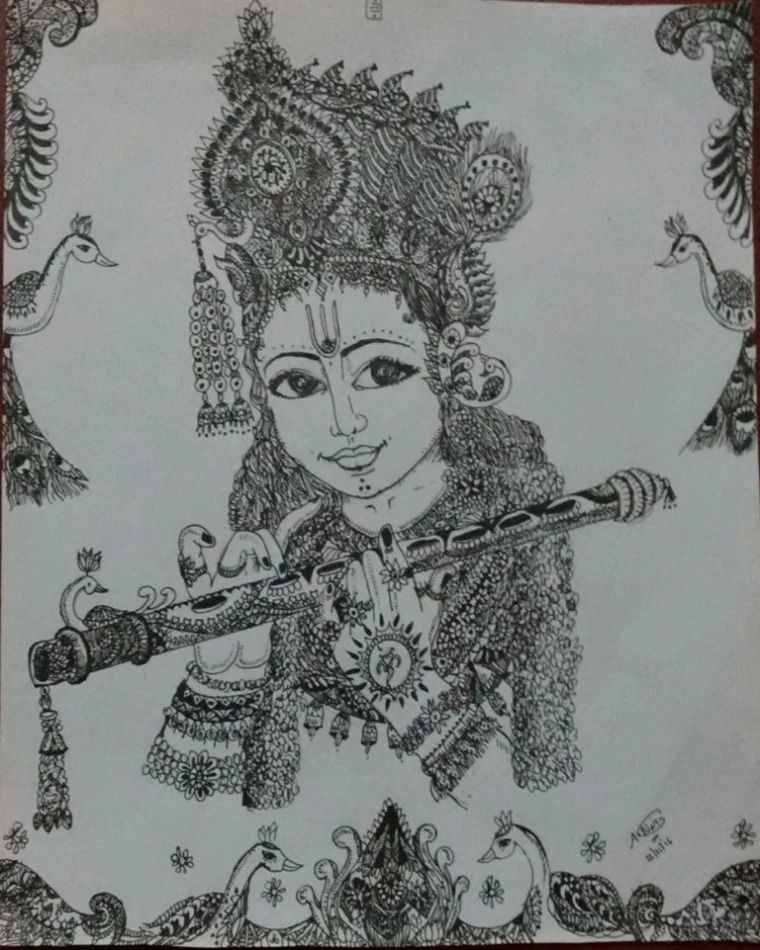The essence of Krishna's divine persona has inspired countless artists across generations, each striving to capture his charm and playful spirit through the strokes of their brushes. The journey of illustrating Krishna is not just about recreating a deity but delving into a world filled with love, mischief, and profound wisdom. Radha Krishna Drawing embodies not only the physical attributes of the beloved god but also the emotional and spiritual connection that devotees share with him.
In exploring Krishna drawing images, artists often bring forth their unique interpretations, influenced by cultural contexts and personal experiences. From the vibrant colors of traditional Indian art to the delicate strokes of contemporary styles, these illustrations portray various facets of Krishna's life – from his enchanting childhood in Vrindavan to his roles as a lover, a warrior, and a divine guide. This rich tapestry of artistic expression invites viewers to immerse themselves in the stories and lessons that each image conveys, making the act of viewing an artwork a spiritual experience in itself.
The Essence of Krishna in Art
The representation of Krishna in art is not just a portrayal of a historical or mythological figure; it captures the divine essence and multifaceted nature of this beloved deity. Artists draw inspiration from the rich narratives of Krishna's life, which encompass themes of love, mischief, and profound wisdom. Each stroke of the brush seeks to reveal the enchanting personality of Krishna, portraying him as the mischievous child, the divine lover, or the wise guide. This diversity allows viewers to connect with Krishna on multiple levels, inviting deeper contemplation of their own spiritual journeys.
Krishna's imagery often features vibrant colors and intricate details that reflect the beauty of his form and the joy he brings to his devotees. From his playful antics with the gopis to his powerful role in the Mahabharata, Krishna's character is rendered in ways that evoke a spectrum of emotions. Artists utilize various techniques to convey not only the physical appearance of Krishna but also the warmth of his presence and the love he embodies. Each artwork serves as a window into the spiritual world, offering a glimpse of the divine and the timeless stories surrounding him.
Moreover, the cultural significance of Krishna drawings transcends mere aesthetics, serving as an essential part of devotional practice. These images inspire feelings of devotion and connection, as devotees often surround themselves with representations of Krishna to feel his presence in their daily lives. The act of creating or admiring Krishna drawing images becomes a form of spiritual expression, bridging the gap between the earthly and the divine. As such, art becomes a vital medium through which the essence of Krishna continues to flourish across generations and cultures.
Techniques for Capturing Krishna
When illustrating Krishna, artists often employ a variety of techniques to convey his divine nature. One popular approach is the use of vibrant colors, which reflect the joyful and playful essence of Krishna. Artists typically choose bold blues and radiant yellows to symbolize his divine characteristics. These colors not only attract attention but also evoke emotions that resonate with devotees, making the artwork more impactful.
Another effective technique is the incorporation of movement and dynamism in the images. Krishna is often depicted in playful poses, such as dancing or playing the flute, which convey a sense of vitality. Little Krishna Drawing can achieve this by using flowing lines and fluid shapes that guide the viewer's eye throughout the composition. The inclusion of natural elements, like swirling clouds or flowing water, can further enhance the sense of motion and connect Krishna with the surrounding world.
Additionally, expressive facial features are crucial for capturing the essence of Krishna. Artists pay close attention to conveying emotions through the eyes and smile, reflecting his compassion and charm. https://www.krishnadrawing.in/category/krishna-drawing of expressions, combined with symbolic elements like peacock feathers or lotuses, help to create a deeper connection with the audience, inviting them to experience the divine presence of Krishna through the artwork.
Influence of Krishna on Contemporary Artists

The figure of Krishna has long transcended the bounds of religious iconography to inspire modern artists across various mediums. His playful persona and deep philosophical associations provide a rich narrative backdrop, allowing contemporary creators to explore themes of love, joy, and divine playfulness. Many artists are drawn to the imagery associated with Krishna, such as the enchanting moments of his childhood, his flirtations with the gopis, or the profound teachings of the Bhagavad Gita. These elements not only serve as visual inspiration but also as catalysts for deeper exploration into human emotions and spiritual journeys.
In recent years, artists have begun to reinterpret Krishna in innovative ways that resonate with contemporary society. From abstract representations to mixed media installations, the traditional depictions of Krishna are evolving. This shift reflects a broader trend where spiritual figures are portrayed in contexts that challenge societal norms and provoke thought. Through their art, contemporary artists encourage viewers to reconsider the stories of Krishna, merging them with modern themes such as identity, gender, and environment, thus keeping the essence of Krishna alive while making it relevant for today's audience.
The resurgence of interest in Krishna has also fostered a collaborative environment, where artists from diverse backgrounds come together to share their interpretations. Galleries and exhibitions dedicated to Krishna Drawing Images have become platforms for dialogue among artists, scholars, and audiences alike. This collective exploration not only enriches the artistic landscape but also creates a community that appreciates the multifaceted nature of Krishna's persona. As contemporary artists continue to capture and reimagine Krishna, they contribute to an evolving narrative that connects ancient spirituality with modern art.

